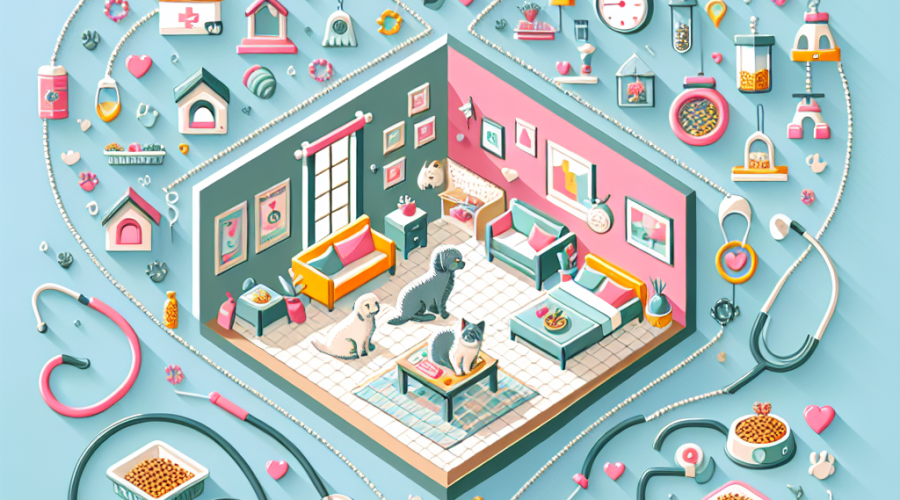Creating the Perfect Environment for Your Indoor Pet: Tips for Optimum Comfort and Safety
Creating a cosy sanctuary for your beloved indoor pet is more than just providing food, water, and a place to sleep. It’s about identifying their needs and preferences to create an environment where they can live happily and healthily. So, where do you start?
The Basics: Space and Cleanliness
Let’s talk about space. Just like us, our pets need their own ‘me’ space to relax and unwind. For dogs and cats, a cosy bed or mat in a quiet corner will do the trick. Smaller pets like rodents or birds need spacious cages with lots of room to explore and exercise. Keeping their living space clean is also essential. Regular cleaning prevents bad odours and the growth of bacteria and parasites that could harm your pet. Remember, a clean pet is a happy pet.
Understanding Their Instincts
It’s crucial to remember that our indoor pets still carry the instincts of their wild ancestors. For instance, cats love to scratch to keep their claws sharp, so a scratching post is a must-have. Dogs, especially puppies, love to chew. Providing chew toys can save your furniture from being gnawed to bits. Birds need perches and swing toys to keep them mentally stimulated. It’s all about understanding their natural behaviours and catering to those needs.
Keeping Them Entertained
Pets can get bored too! Especially if they’re spending most of their time indoors. Toys and playthings are essential to keep them entertained. You can even DIY some toys at home. For example, an old sock filled with crumpled paper can make a great plaything for a cat. Remember, playtime is also a great way to bond with your pet.
Home Safety for Pets
We love our pets and want to protect them from harm. But did you know that your home can house several potential hazards for your pets? Things like wires, toxic plants, and small objects that can be swallowed should be kept out of their reach. Always remember, pet-proofing your home is just as important as baby-proofing!
Managing Their Diet
Just like humans, pets also need a balanced and nutritious diet. It’s important to research what foods are suitable for your pet. You might be surprised to know that some human foods can be toxic to pets. For example, chocolate, grapes, and onions are a no-no for dogs. It’s always a good idea to consult with a vet to create a diet plan for your pet.
Keeping Them Active
Even if your pet is living indoors, they still need regular exercise to keep them fit and healthy. Dogs will benefit from daily walks or play sessions in the local park. Cats can be enticed to move with laser pointers or feather toys. If you have a small pet like a hamster or a rabbit, make sure their cage has a wheel or tunnels for them to run around in.
Creating the perfect environment for your indoor pet requires understanding and catering to their needs. Whether it’s providing the right toys to play with, ensuring a safe home environment, or maintaining a healthy diet and exercise routine, every little detail contributes to their overall wellbeing. Remember, a happy pet means a happy home!
There’s no one-size-fits-all solution when it comes to pets. Each creature is unique, with its own set of needs and preferences. So, take the time to understand your pet, and you’ll be well on your way to creating a home that’s perfect for them. Because, at the end of the day, isn’t that what we all want – to give our pets the best life possible?
FAQs
Q: What key factors should I consider when creating the perfect environment for my indoor pet?
A: The main elements to consider include space, cleanliness, temperature, noise level, and accessibility to necessities like food, water, and toys. These factors contribute significantly to your pet’s comfort, safety, and overall well-being.
Q: How can I ensure that my home’s temperature is suitable for my indoor pet?
A: Monitoring and adjusting your home’s temperature according to your pet’s species-specific needs is critical. For instance, tropical pets like parrots or reptiles may need warmer temperatures, while others like dogs and cats thrive in a cooler environment.
Q: What role does noise play in an indoor pet’s environment?
A: Noise can significantly impact your pet’s stress levels. It’s important to provide a quiet, tranquil environment to keep your pet calm and comfortable, while occasional exposure to moderate noise can help them get accustomed to typical household sounds.
Q: How can I make my home safe for my indoor pet?
A: To ensure safety, remove small, swallowable items, toxic plants, and harmful chemicals from your pet’s reach. Also, use pet gates or enclosures to limit access to potentially dangerous areas like kitchens or staircases.
Q: Why is it essential to have a designated space for my indoor pet?
A: Providing a designated space for your pet with their bed, toys, and food gives them a sense of security. It also helps in managing their behaviour, as they understand this area to be their personal space.

